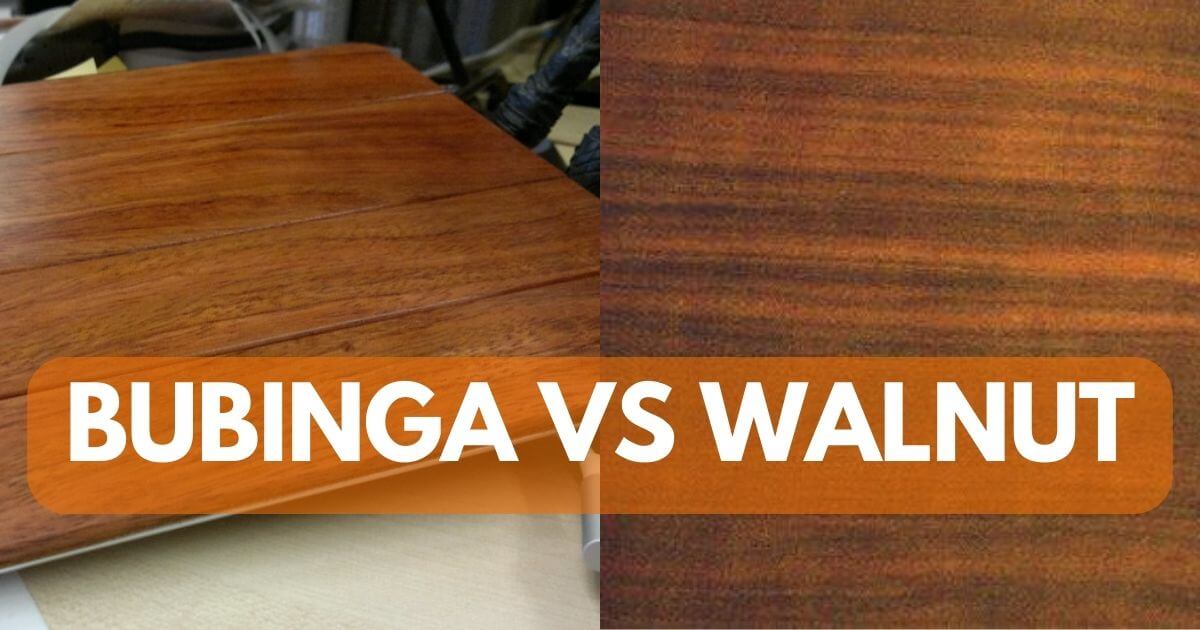Bubinga wood is generally denser and heavier than walnut wood, which can be more challenging to work with. However, its density makes it more durable and resistant to wear and tear.
If we compare the texture, Bubinga wood has a fine to medium texture, while walnut wood has a medium to coarse texture.
Bubinga Wood
Bubinga wood, also known as African rosewood, comes from several species of trees in the genus Guibourtia, which are native to Africa. It is a very dense and strong wood. Several species of Bubinga have similar properties.
Bubinga hardwood is a popular choice for high-end furniture, cabinetry, and musical instruments.
Walnut Wood
Walnut wood is a type of hardwood that comes from the trees of the Juglans genus. There are several species of walnut tree, but the two species most famous for woodworking are black walnut and English walnut. Walnut wood is moderately durable and strong, suitable for furniture and musical instruments.
Black walnut is native to North America and has a rich, dark brown color, while English walnut is native to Eastern Europe and Western Asia. It has a lighter, more golden brown color.
| Bubinga Wood | Walnut wood | |
| Scientific name | Guibourtia spp. | Juglans |
| Tree Size | 130-150 feet (40-45 meters) tall | 70-80 feet (22-25 meters) tall |
| Janka Hardness | 2,410 lbf (10,720 N) | 1,220 lbf (5,410 N) (English Walnut) |
| Average weight | 56 lbs/ft3 (890 kg/m3) | 40 lbs/ft3 (640 kg/m3) (English Walnut) |
| Workability | Easy to work | Easy to work |
| Rot-Resistant | Not rot resistant | Moderately resistant to rot |
Bubinga Wood Uses
Bubinga wood is a popular choice for various woodworking projects due to its strength, durability, and natural rot resistance. Bubinga wood is widely used for veneer, inlays, high-end furniture, cabinetry, turnings, architectural millwork, knife handles, and other specialty items.
Bubinga wood is an excellent choice for making guitar bodies, basses, and drums due to its tonal qualities and ability to produce a bright, focused sound.
Walnut Wood Uses
Walnut is a popular hardwood for various woodworking applications such as furniture, veneer, flooring, millwork, cabinetry, gunstocks, interior paneling, and Musical instruments.
Appearance
The heartwood of Bubinga wood ranges from pinkish red to dark reddish-brown with black streaks, and the sapwood is pale straw. It has a fine to medium texture with a straight or interlocked grain pattern.
Walnut wood can range from light brown to medium brown in color with dark streaks. Walnut wood has a medium to coarse texture with a straight or irregular grain pattern.
Bubinga wood darkens with age; on the other hand, Walnut wood becomes Walnut lightens over time.
Workability
Generally, Bubinga wood is easy to work with, but it also depends on the species of Bubinga. Due to its interlocking and irregular grain, there may be a problem like tear-out during planer or other machining operations.
Walnut wood is easy to work with. It finishes very well and gives excellent results. Its irregular or interlocked grain can cause problems for a beginner.
Hardness
Generally, The density and weight of Bubinga is more than Walnut wood but the wood’s hardness and other physical properties depend on the species.
The Janka hardness of Bubinga and walnut wood is in the table below. So that you can compare hardness.
| Wood Species | Janka Hardness |
| New Guinea Walnut | 910 lbf (4,040 N) |
| African Walnut | 940 lbf (4,180 N) |
| Peruvian Walnut | 960 lbf (4,250 N) |
| Black Walnut | 1,010 lbf (4,490 N) |
| Claro Walnut | 1,130 lbf (5,030 N) |
| English Walnut | 1,220 lbf (5,410 N) |
| Bastogne Walnut | 1,250 lbf (5,560 N) |
| Queensland Walnut | 1,670 lbf (7,380 N) |
| Bubinga | 2,410 lbf (10,720 N) |
Rot and Insect Resistant
Regarding rot resistance, both Bubinga and walnut wood are known for their durability and resistance to decay. Still, Bubinga wood is moderately resistant to insects and rot, while Walnut wood is highly resistant to rot but susceptible to insect attack.
Walnut is one of the popular woods for interior woodworking projects like furniture and flooring but is unsuitable for exterior applications.
Overall, both buying and walnut are relatively rot-resistant wood that can be used for various products. But exterior sealing is recommended for outdoor use.
Allergies
Both kinds of wood have been reported to cause skin irritation, and walnut has been reported as a sensitizer. So be careful while working with these woods.

